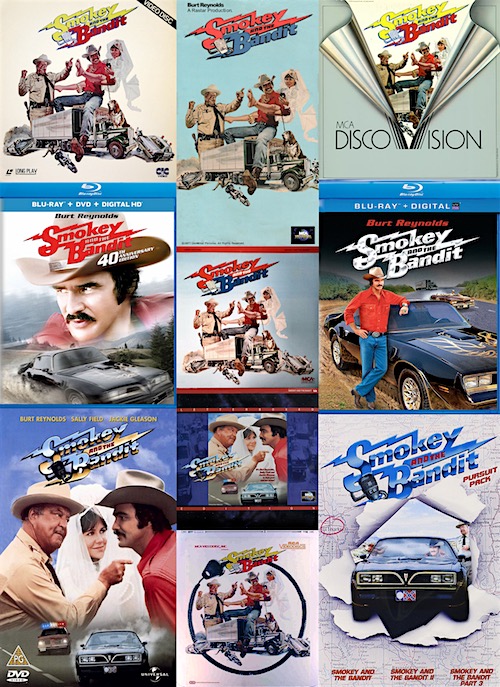Smokey and the Bandit, the directorial debut of former stuntman Hal Needham, opened 40 years ago this month, and for the occasion The Bits features a compilation of statistics, trivia and box-office data that places the movie’s performance in context; passages from vintage film reviews; a reference/historical listing of the film’s first-run theatrical engagements; and, finally, an interview segment with 1970s film authority Lee Pfeiffer.
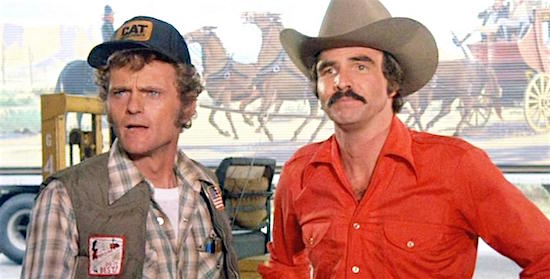
BANDIT NUMBER$
- 1 = Box-office rank among films in the Bandit series
- 1 = Box-office rank among films directed by Hal Needham
- 1 = Box-office rank among films starring Burt Reynolds (adjusted for inflation)
- 1 = Number of Academy Award nominations
- 1 = Number of opening-week engagements
- 1 = Number of weeks North America’s top-grossing movie (week #2)
- 1 = Rank among top-earning movies during first weekend of “wide” release
- 2 = Rank among top-earning movies of 1977 (calendar year)
- 2 = Rank among top-earning movies of 1977 (summer season)
- 3 = Rank among top-earning movies of 1977 (legacy)
- 3 = Rank among Universal’s all-time top-earning movies at close of original run
- 6 = Number of sequels, remakes and spin-offs
- 8 = Rank on all-time list of top box-office earners at close of original release
- 12 = Rank among top-earning movies of the 1970s
- 27 = Number of weeks of longest-running engagement
- 36 = Number of months between theatrical release and home-video release
- 71 = Rank on current list of all-time top-grossing films (adjusted for inflation)
- 386 = Number of opening-week engagements (Week #2; first week “wide”)
- $29.95 = Suggested retail price of initial home video release (videodiscs)
- $79.95 = Suggested retail price of initial home video release (Beta & VHS)
- $1.7 million = Opening-weekend box-office gross (3-day; May 27-29)
- $2.3 million = Opening-weekend box-office gross (4-day holiday; May 27-30)
- $4.3 million = Production cost
- $9.4 million = Opening-weekend box-office gross (adjusted for inflation)
- $17.4 million = Production cost (adjusted for inflation)
- $61.1 million = Box-office rental (domestic)
- $126.7 million = Box-office gross (domestic)
- $198.5 million = Box-office gross (domestic; entire Bandit series)
- $246.4 million = Box-office rental (domestic, adjusted for inflation)
- $511.4 million = Box-office gross (domestic, adjusted for inflation)
- $721.6 million = Box-office gross (domestic; entire Bandit series; adjusted for inflation)
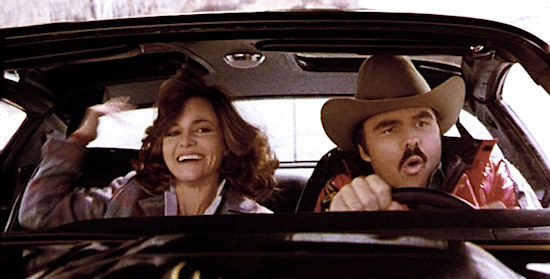
A SAMPLING OF MOVIE REVIEWER QUOTES
“Smokey and the Bandit is a good summer saturation comedy entry starring Burt Reynolds as a bootlegger-for-kicks who, with Jerry Reed and Sally Field, outwit zealous sheriff Jackie Gleason…. [S]tunt coordinator Hal Needham’s directorial debut is promising. The Universal release should perform well in fast playoff, and be a serviceable dual bill partner thereafter.” — A.D. Murphy, Variety
“Smokey and the Bandit tries hard to be a Good Ole Movie and sometimes succeeds. Burt Reynolds, with high-pitched laugh and constant good spirits, plays the trucking hero; and if his style is too practiced to be called casual, it at least fits the mood of the picture. [I]t’s basically a B movie, but with fancy wrappings. It’s also a reverse snob. It takes genuine pride in its lack of pretentions and wallows in its mediocrity.” — Philip Wuntch, The Dallas Morning News
“Smokey and the Bandit is for everybody who is crazy about Burt Reynolds, crazy about cars, crazy about car chases, crazy about CB radio.” — Gene Shalit, The Today Show
“[Smokey and the Bandit] is the kind [of movie] you enjoy when you don’t mind staying awake but are too tired to think. It is not unmitigated good fun even at its own level of internally combusted slapstick. Burt Reynolds and Jerry Reed are pleasant to be around, and Sally Field turns the extraordinary feat of being wistfully sweet, sympathetic and funny in a part you’d have said was left on the doorstep in a blizzard. Jackie Gleason, stuck as the story’s buffoon-villain, a sorghumland sheriff with the wit and charm of a stalled steamroller, gets lines that fall on the far side of whatever divides witty irascibility from loud nastiness.” — Charles Champlin, Los Angeles Times
“Jaunty fun.” — Richard Schickel, Time
“Smokey and the Bandit is an hour and a half and maybe two dozen wrecked police cars long. Most of its dialogue consists of braying into CB microphones about ‘go-go juice’ and courses of action being ‘negatory.’ For those with no passion for mumbling cryptic southernisms at strangers, the film is sheer purgatory.” — Desmond Ryan, The Philadelphia Inquirer
“Reynolds is tough because he can drive fast. Reynolds is sweet because he smiles. For my money, Reynolds and his cracker act are as phony as a three-dollar bill. The man reeks of Las Vegas, from his dapper moustache to his turquoise jewelry, and all his CB lingo (‘Hey there, good buddy’) can’t disguise the fact that he looks like he belongs behind a roulette wheel.” — David Rosenbaum, The Boston Herald American
“Smokey and the Bandit is the latest Good Ol’ Movie from Burt Reynolds, who does this sort of thing better than anyone else (even if he doesn’t always convince us that it should be done at all). It’s basically a chase movie, and chases have been the staple of the movies, almost since they were invented. Chases used to be mostly on foot or horseback; now they’re in cars. The American movie going public seems to be ready for at least one big one a year.” — Roger Ebert, Chicago Sun-Times
“Gleason’s performance as Sheriff Justice is one of the corniest jobs of overacting I’ve sat through in years.” — Clyde Gilmour, Toronto Star
“Sally Field is kooky and appealing as the runaway bride. And there’s such a noticeable chemistry between her and Reynolds you wonder what went on between the two when the cameras weren’t rolling.” — Charles Brock, The (Jacksonville) Florida Times-Union
“Smokey and the Bandit combines the public’s infatuation for car chases with the current Citizen Band radio fad. Practically the entire film, in fact, is one long car chase. It’s raucous, raunchy and infantile. But the fact that the movie is also contemporary, slapstick and jiving with current CB jargon will make it attractive to those in the mood for a fast-paced comedy adventure. For me, it was a crashing bore.” — Donna Chernin, The (Cleveland) Plain Dealer
“With Mr. Reynolds playing it cool and Mr. Gleason doing his burns and investing the film with a certain raunchy humor, the rest is up to the vehicles. And they don’t do anything that hasn’t been seen before.” — Lawrence Van Gelder, The New York Times
“Pure idiocy.” — Gannett News Service
“It has considerably less charm than W.W. and the Dixie Dancekings, another Reynolds ‘Southern’ that made it big only in the South, and its comedy formula and techniques are so crude and slapdash that it’s less like a typical ‘Southern’ than a particularly obnoxious Disney chase comedy — this time with abusive anti-cop and toilet jokes…. Take out the outhouse humor and the CB radio gadgetry, replace Gleason with Don Knotts, Reynolds with Dean Jones and Field with Suzanne Pleshette, and you’ve got Herbie Rides Again.” — John Hartl, The Seattle Times
THE ORIGINAL ENGAGEMENTS
Listed here for historical reference and nostalgia for those who saw Smokey and the Bandit early in its release are the theaters in which the movie opened during its first two weeks of release.
A distribution/exhibition overview: Smokey and the Bandit initially opened exclusively at the fabled Radio City Music Hall in New York City, opening there on May 19th, 1977, in what could be described as an out-of-place, pre-release booking. A week later on the 27th, Universal opened the movie in a massive “regional saturation” release throughout the South and Southwest. This portion of the launch booked theaters in towns of all sizes but was restricted to thirteen states and was designed to capitalize on the Southern theme and setting of the movie and star Burt Reynolds’ popularity in that region. That, and the fact Universal believed the movie would have performed poorly nationwide if it didn’t generate positive word of mouth from the early playdates. (Additional Southern openings, primarily in small towns, continued throughout June and early July of ’77.)
In what was a fairly slow rollout nationally, the major markets in the rest of North America finally started to play the movie during July ’77. These aren’t included in the reference listing below, but to illustrate the rollout, some of the major market openings included: July 15th (Boston), July 22nd (Toronto, New York City expansion), July 29th (Baltimore, Chicago, Cincinnati, Cleveland, Los Angeles, Louisville, Philadelphia, Phoenix, Pittsburgh, Portland, St. Louis, San Diego, San Francisco, Washington DC), August 12th (Detroit) and August 19th (Seattle).
And, here were the May 27th openings of Smokey and the Bandit…
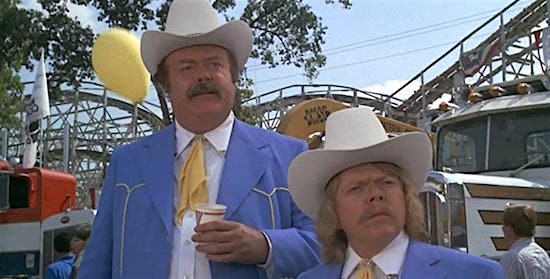
ALABAMA
- Albertville — Mall Twin
- Anniston — Cheaha
- Auburn — Tiger
- Birmingham — Eastwood Mall Twin
- Birmingham — Five Points West Twin
- Cullman — Martin Twin
- Decatur — Gateway Twin
- Dothan — Northside 4-plex
- Enterprise — College
- Fort Payne — DeKalb
- Gadsden — Agricola
- Huntsville — Alabama
- Mobile — Village 4-plex
- Montgomery — Martin Twin
- Muscle Shoals — Cinema Twin
- Phenix City — Phenix Twin
- Scottsboro — Holiday
- Selma — Cahaba Twin
- Tuscaloosa — Capri
ARKANSAS
- Benton — Twin
- Blytheville — Malco Twin
- El Dorado — El Dorado Triplex
- Fayetteville — Malco Twin
- Fort Smith — Phoenix Village Twin
- Hot Springs — Malco Twin
- Jacksonville — Flick Twin
- Jonesboro — Plaza Twin
- Little Rock — Cinema City 4-plex
- Little Rock — Four 4-plex
- Marianna — Gene Boggs Twin
- Pine Bluff — Broadmoor Twin
- Russellville — Picwood Twin
- West Helena — Gene Boggs Twin
FLORIDA
- Altamonte Springs — Altamonte Mall Twin
- Arcadia — Arcadia Twin
- Bartow — Bartow Mall
- Boca Raton — Boca Mall 6-plex
- Bradenton — Bayshore Twin
- Bradenton — Skyway Drive-In
- Brandon — Brandon Twin
- Brooksville — Brooksville Twin
- Clearwater — Carib
- Coral Gables — Riviera Twin
- Dania Beach — Hi Way Drive-In
- Daytona Beach — Bellair Plaza Twin
- Daytona Beach — Sunshine Mall Twin
- Delray Beach — Delray Drive-In
- Englewood — Palm Plaza Twin
- Fort Lauderdale — Sunrise Twin
- Fort Myers — Edison Mall
- Fort Pierce — Village Twin
- Fort Walton Beach — Palm
- Gainesville — Royal Park 4-plex
- Hallandale Beach — Diplomat Mall Twin
- Hollywood — Plaza Twin
- Jacksonville — Cedar Hills
- Jacksonville — Expressway Mall Twin
- Jacksonville — Main Street Drive-In
- Jacksonville — Northside Twin
- Jacksonville — Southside Drive-In
- Jacksonville — Village Twin
- Key West — Cinema Twin
- Lake City — Cinema 90 Twin
- Lakeland — Polk
- Lauderdale Lakes — Lakes 6-plex
- Leesburg — Vista
- Margate — Margate Twin
- Melbourne — NASA
- Merritt Island — Merritt Twin
- Miami — Concord Twin
- Miami — Coral Way Drive-In
- Miami — Cutler Ridge Twin
- Miami — Miami Drive-In
- Miami — Omni 6-plex
- Miami — Thunderbird Twin
- Miami Beach — Surf
- Naples — Gulfgate
- Neptune Beach — Neptune
- New Port Richey — Southgate Twin
- North Miami Beach — 170th Street Twin
- North Miami Beach — Golden Glades Drive-In
- North Palm Beach — Twin City Twin
- Ocala — Springs Twin
- Okeechobee — Braham
- Orlando — Colonial Drive-In
- Orlando — Orange Ave. Drive-In
- Orlando — Parkwood Twin
- Ormond Beach — Nova Drive-In
- Palm Springs — Dolphin
- Panama City — Florida Triplex
- Pensacola — Westwood 4-plex
- Pinellas Park — Pinellas Square Triplex
- Plant City — Plant Mall Twin
- Port Charlotte — Promenades Twin
- St. Augustine — Plaza Twin
- St. Petersburg — Crossroads Twin
- St. Petersburg — Mustang Drive-In
- Sanford — Sanford Plaza Twin
- Sarasota — South Trail
- Sebring — Southgate
- Stuart — Mayfair
- Tallahassee — Capitol Drive-In
- Tallahassee — Tallahassee Mall Twin
- Tampa — Eastlake Square Triplex
- Tampa — Hillsboro Drive-In
- Tampa — Horizon Park 4-plex
- Tampa — Twin Bays 4-plex
- Tampa — Varsity 6-plex
- Titusville — Miracle City Twin
- Venice — Jacaranda Plaza Twin
- Vero Beach — Plaza
- West Palm Beach — Palm Beach Mall 4-plex
- Winter Haven — Continental
- Winter Park — Park Twin
GEORGIA
- Albany — Martin
- Athens — Beechwood Twin
- Atlanta — Northlake Triplex
- Atlanta — Tara Twin
- Augusta — Daniel Village Twin
- Brunswick — Lanier Twin
- Carrollton — Village
- Chamblee — Northeast Expressway Drive-In
- Columbus — Columbus Square Twin
- Covington — Newton
- Dalton — Capri
- Decatur — Glenwood Drive-In
- Decatur — South Dekalb Twin
- Dublin — Martin
- Fayetteville — Fayette
- Fort Oglethorpe — Southgate Twin
- Gainesville — Sherwood
- Griffin — Parkwood Triplex
- Hinesville — Brice Twin
- Jonesboro — Arrowhead Triplex
- LaGrange — LaGrange
- Mableton — Mableton Twin
- Macon — Westgate Triplex
- Marietta — Town & Country Twin
- Milledgeville — Martin
- Moultrie — Colquitt
- Newnan — Alamo
- Rome — Village
- Savannah — Cinema Centre Triplex
- Statesboro — Georgia
- Thomasville — Ritz
- Tifton — Tift
- Valdosta — Cinema Twin
- Vidalia — Brice
- Warner Robins — Rama
- Waycross — Mall Twin
KENTUCKY
- Bowling Green — Martin
- Franklin — Martin
- Hopkinsville — 31 West Drive-In
- Murray — Cheri Triplex
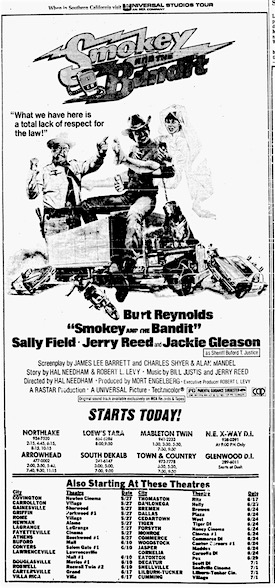
LOUISIANA
- Alexandria — Don
- Baton Rouge — Broadmoor Twin
- Baton Rouge — North Park Twin
- Bogalusa — Trackside Twin
- Hammond — Ritz
- Houma — Southland Twin
- Monroe — Plaza
- Morgan City — Lake Twin
- New Orleans — Joy
- New Orleans — Plaza 4-plex
- Opelousas — Vista Village Twin
- Ruston — Village
- Shreveport — St. Vincent 6-plex
- Shreveport — Southpark Twin
- Slidell — Tammany Mall Twin
MISSISSIPPI
- Biloxi — Edgewater Plaza 4-plex
- Clarksdale — Showcase
- Cleveland — Cinema Twin
- Columbus — Malco Twin
- Greenville — Plaza
- Greenwood — Highland Park Twin
- Gulfport — Hardy Court Twin
- Hattiesburg — Avanti
- Jackson — DeVille
- Laurel — Northside Twin
- McComb — Twin
- Meridian — 8th Street
- Natchez — Tracetown Twin
- Oxford — Ritz
- Pascagoula — Towne
- Starkville — Cinema 12 Twin
- Tupelo — Malco Twin
- Vicksburg — Battlefield Twin
NEW MEXICO
- Albuquerque — Fox Winrock
- Clovis — Hilltop Twin
- Gallup — Aztec Twin
- Santa Fe — The Movies! Twin
- Silver City — Gila
NORTH CAROLINA
- Asheboro — Cinema Twin
- Asheville — Dreamland Drive-In
- Asheville — Merrimon Twin
- Boone — Chalet Twin
- Burlington — Park
- Chapel Hill — Carolina Twin
- Charlotte — Charlottetown Mall Triplex
- Charlotte — Eastland Mall Triplex
- Clinton — Cinema
- Concord — Carolina Mall Triplex
- Dunn — Plaza Twin
- Durham — Northgate Twin
- Elizabeth City — Carolina
- Fayetteville — Cross Creek Mall Triplex
- Gastonia — Diane Drive-In
- Goldsboro — Center
- Greensboro — Carolina Circle 6-plex
- Greensboro — Quaker Twin
- Greenville — Pitt
- Havelock — Cinema
- Henderson — Embassy
- Hendersonville — Carolina Twin
- Hickory — Thunderbird Drive-In
- High Point — Twin
- Jacksonville — Northwoods
- Kinston — Mall
- Laurinburg — Gibson
- Lenoir — Cinema Triplex
- Lincolnton — Century
- Lumberton — Cinema Triplex
- Morehead City — Cinema Twin
- Morganton — Studio Twin
- Mount Airy — Mayberry
- Nags Head — Colony House
- New Bern — Cinema
- Raleigh — Mission Valley Twin
- Roanoke Rapids — Cinema
- Rocky Mount — Cardinal Twin
- Salisbury — Center
- Sanford — Cinema Twin
- Shelby — Flick
- Southern Pines — Town & Country Twin
- Statesville — Newtowne
- Washington — Cinema Twin
- Wilmington — Oleander Twin
- Wilkesboro — College Park
- Wilson — Starlite Drive-In
- Winston-Salem — Haines Mall 4-plex
OKLAHOMA
- Ada — Gemini Twin
- Alva — Rialto
- Bartlesville — Eastland Twin
- Enid — Video Twin
- Guymon — Suburban
- Lawton — Vaska
- McAlester — Cinema 69 Twin
- Muskogee — Muskogee Twin
- Norman — Heisman 4-plex
- Oklahoma City — 14 Flags Drive-In
- Oklahoma City — French Market Twin
- Oklahoma City — Reding 4-plex
- Pryor — Allred
- Sapulpa — Creek Hills
- Shawnee — Hornbeck Twin
- Stillwater — Aggie
- Tulsa — Boman Twin
- Weatherford — Vesta
- Woodward — Lakeside
SOUTH CAROLINA
- Aiken — Mark I
- Anderson — Osteen Twin
- Charleston — Ashley Plaza Twin
- Chester — Cinema Twin
- Clemson — Clemson
- Columbia — Miracle
- Conway — Holiday
- Easley — Colony Twin
- Florence — Crown
- Greenville — Tower
- Greenwood — Auto Drive-In
- Greer — Cinema Triplex
- Hartsville — Cinema
- Lancaster — Crown
- North Charleston — Charles Towne Square Twin
- Orangeburg — Camelot Twin
- Rock Hill — Cinema
- Spartanburg — Pinewood Twin
- Sumter — Wesmark Plaza Twin
- Union — Duncan
TENNESSEE
- Bristol — Holiday
- Chattanooga — Northgate Triplex
- Clarksville — Martin Twin
- Cleveland — Cinema Twin
- Columbia — Polk
- Cookeville — Princess
- Dyersburg — Martin Twin
- Gatlinburg — Gatlinburg
- Goodletsville — Rivergate Mall Twin
- Jackson — Paramount
- Johnson City — Mall
- Kingsport — Martin
- Knoxville — Cedar Bluff Twin
- Knoxville — Studio One
- Madisonville — Martin
- Maryville — Druid Hill Drive-In
- McMinnville — Park
- Memphis — Plaza Twin
- Memphis — Raleigh Springs Mall Twin
- Memphis — Whitehaven Twin
- Morristown — Princess
- Murfreesboro — Martin Twin
- Nashville — Martin
- Oak Ridge — Grove
TEXAS
- Abilene — Westgate Twin
- Alice — Sage
- Alvin — Town Plaza Twin
- Amarillo — Western Square Twin
- Arlington — Six Flags Mall Twin
- Austin — Highland Mall Twin
- Baytown — Brunson Twin
- Beaumont — Gateway Twin
- Big Spring — R/70
- Brownfield — Regal Twin
- Brownwood — Commerce Square Twin
- Brownsville — North Park Plaza Twin
- Bryan — Manor East Triplex
- Conroe — North Hills
- Copperas Cove — Cinema 76
- Corpus Christi — Cine 4-plex
- Corsicana — Cinema Twin
- Dallas — Esquire
- Dallas — Valley View Twin
- Del Rio — Rita Twin
- Denton — Fine Arts
- Dumas — Evelyn
- El Paso — Cielo Vista Mall Triplex
- Fort Worth — Wedgwood Twin
- Galveston — Galvez Plaza Triplex
- Gatesville — Town & Country Drive-In
- Greenville — Rolling Hills Twin
- Harker Heights — Showplace Triplex
- Harlingen — Morgan Plaza Twin
- Houston — Alabama
- Houston — Almeda 9-plex
- Houston — Champions Village Twin
- Houston — Gaylynn Triplex
- Houston — Greenspoint 5-plex
- Houston — Northwest 4-plex
- Houston — Woodlake Triplex
- Huntsville — Cinema Triplex
- Hurst — Belaire Twin
- Irving — Irving Mall Twin
- Kerrville — Plaza
- Killeen — Plaza
- Kingsville — Texas
- Lake Jackson — Lake Twin
- Laredo — Cinema Twin
- Lewisville — Cinema Twin
- Longview — Cargill Triplex
- Lubbock — Showplace 4-plex
- Lufkin — Cinema Twin
- Marshall — Cinema Twin
- McAllen — Cinema Twin
- Mesquite — Town East Twin
- Midland — Cinema 1
- Nacogdoches — Stephen F. Austin Center
- New Braunfels — Cinema Twin
- Odessa — Grandview
- Orange — Brown Twin
- Paris — Cinema Twin
- Port Arthur — Village Triplex
- Richmond — Lamar
- San Angelo — Sherwood Twin
- San Antonio — North Star Mall Twin
- San Antonio — South Park Mall 4-plex
- San Marcos — Holiday
- Seguin — Palace Twin
- Sherman — Cinema Twin
- Snyder — Cinema Twin
- Sugar Land — Palms
- Temple — Arcadia
- Texarkana — Cinema City Triplex
- Texas City — Tradewinds Twin
- Tyler — Cinema Twin
- Victoria — Playhouse 4-plex
- Waco — Cinema Twin
- Wichita Falls — Wichita
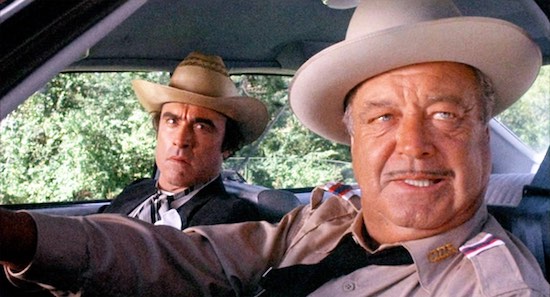
THE Q&A
Lee Pfeiffer is the Editor-in-Chief of Cinema Retro magazine, which celebrates films of the 1960s and 1970s and is “the Essential Guide to Cult and Classic Movies.” He is the author (with Philip Lisa) of The Incredible World of 007: An Authorized Celebration of James Bond (Citadel, 1992) and The Films of Sean Connery (Citadel, 2001), and (with Dave Worrall) The Essential Bond: The Authorized Guide to the World of 007 (Boxtree, 1998/Harper Collins, 1999). He also wrote (with Michael Lewis) The Films of Harrison Ford (Citadel, 2002) and (with Dave Worrall) The Great Fox War Movies (20th Century Fox Home Entertainment, 2006).
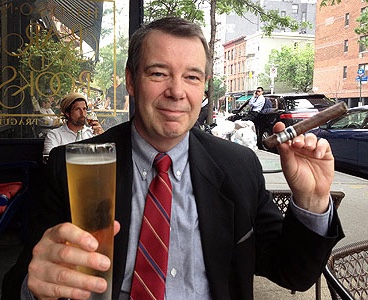
---
Michael Coate (The Digital Bits): In what way should Smokey and the Bandit be remembered on its 40th anniversary?
Lee Pfeiffer: The film spoke to a certain demographic — people who lived in rural America — in a way that Hollywood productions of the era rarely succeeded in doing. There was a time when studios courted this market specifically by churning out low-budget action movies, Westerns, comedies and exploitation films but as audiences became more demanding in their tastes, public sentiment switched to glossier productions. Indeed, as far back as 1935, Variety ran a famous headline “Hix Nix Stix Pix,” meaning that films that were specifically targeted for rural audiences were being ignored in favor of big movies with big stars. The success of Smokey reawakened studio interest in producing films targeted to people who didn’t live in major urban areas. It was a film that boasted big stars and good production values. Rural audiences felt the movie spoke to them in a way that wasn’t condescending or insulting in the manner that previous attempts to reach their wallets were. Burt Reynolds was riding high at the time. Along with Clint Eastwood, he was arguably the biggest star in the world so the movie’s success didn’t surprise anyone. What did surprise studios was the extent to which it was embraced by rural audiences. The movie played seemingly forever in some theaters in the south and the heartland. It proved to Hollywood that there was plenty of profit movies that spoke to folks who still saw first run movies in drive-in theaters.
Coate: What do you think of Smokey and the Bandit? Can you recall your reaction to the first time you saw it?
Pfeiffer: I think I saw it back in college when I went to a screening to review the film for the campus newspaper. I didn’t like it very much then and probably wouldn’t care for it very much now, though I’ll confess I haven’t seen it in many years. I always liked the work of Burt Reynolds and Sally Field and Jackie Gleason is one of my idols. But I just couldn’t relate to the humor the way some people did. I think it’s really a matter of demographics, specifically where you live. I’m a big city person who grew up with New York City just across the river, so Manhattan was my “playground,” if you will — and still is. Thus, I always related more to Woody Allen comedies than the kind of humor presented in Smokey and the Bandit. That’s not meant to be a knock on the film. I once wrote a book about classic movies and I think I included Smokey in it. My editor was aghast but left it in because I argued that, for the purposes of that specific book, I defined “classic” as any film that had a highly enduring legacy in regard to its intended audience. Smokey wasn’t made to please people who frequent cafes on the East Side of Manhattan. It was made for audiences who could relate to the kinds of eccentric characters you find in small town America in much the same way that Scorsese is able to do the same with characters you find in urban settings. I respect Smokey for its durability. People who loved it back in the day still love it today.
Coate: What did Smokey and the Bandit contribute to 1970s Cinema?
Pfeiffer: The film proved that not every major hit had to be a mega-budget blockbuster. Even by 1977, studios were becoming increasingly reliant on spectacle and special effects. That year alone saw the release of three major hits that relied heavily on technology: Star Wars, Close Encounters of the Third Kind and The Spy Who Loved Me — all fine movies but ones that continued to convince studios that bigger was always better. Smokey reminded them that a film on a fairly modest budget with popular stars could still draw big audiences. Don’t forget there was no cable TV in those days and home video was just in its infancy. The average person could only see a favorite movie again by going to a theater. Smokey played for many weeks, packing in audiences — and then would be revived by popular demand in small town theaters. That type of pattern doesn’t happen today. Even if a movie is a blockbuster, it generally clears out of theaters quickly so the studio can capitalize on the home video and cable sales.
Coate: Where do you think Smokey and the Bandit ranks among director Hal Needham’s body of work?
Pfeiffer: Well, Needham’s “body of work” is pretty thin as director. He was one of the very top stuntmen and stunt coordinators in the business and that is his real legacy. He gravitated to directing because he had worked on so many films he probably felt he could direct one in his sleep. He was also a personal friend of Burt Reynolds and had worked as a second unit director on some of his earlier films. Reynolds’ clout got him the directing gig on Smokey and Needham came through for the studio. However, his career as a director was largely linked to Reynolds’ popularity. They went on to make one good movie together — Hooper — and a couple of dogs that still made a lot of money: The Cannonball Run and Smokey and the Bandit II. He made a couple of other films without Reynolds but they are largely forgotten. He and Reynolds reunited in 1984 for Cannonball Run II but the bloom was already off the rose and the movie didn’t perform very well. Within a couple of years, Needham wasn’t directing any major films. However, it should be acknowledged that the man knew his limitations and stayed within his comfort zone. His films generally contained elaborate stunts and car chases, which were challenges he knew he could always rise to. The fact that we are still talking about Smokey and the Bandit forty years later is probably the greatest testament to his talents.
Coate: Where do you think Smokey and the Bandit ranks among Burt Reynolds’, Sally Field’s and Jackie Gleason’s bodies of work?
Pfeiffer: That’s a pretty subjective question because, in terms of popularity, it probably represents the pinnacle of Burt Reynolds’ career. However, it also laid the groundwork for his rather rapid demise in terms of his box office appeal. As Reynolds himself acknowledged, he began to rely too much on the low-hanging fruit of good ol’ boy country comedies. Clint Eastwood did two such films, co-starring with an orangutan and they were both hits — but he knew when to walk away from the genre. Reynolds didn’t. When he turned down the role that won Jack Nicholson an Oscar for Terms of Endearment in order to do Stroker Ace with Hal Needham, his career was irreparably damaged. In terms of Reynolds’ achievement as a personality, Smokey was a triumph for him because it epitomized how audiences wanted to see him — as the over-sexed, towel-snapping prankster and man of action. In terms of Reynolds’ “serious” efforts, however, I think his star-making dramatic performance in Deliverance is his most impressive work.
For Sally Field, who was romantically involved with Reynolds at the time, this was nothing more than a fun outing. She always had a talent for light comedy and had become a star on the sitcoms Gidget and The Flying Nun, so this was probably nothing more than a pleasant paid holiday for her.
For Jackie Gleason the film was more important. He was one of the most iconic of American comedy stars but his legacy was in danger of being overlooked by younger audiences who only knew him as Ralph Kramden from the eternal comedy series The Honeymooners. Gleason stole the show as Sheriff Buford T. Justice and found a whole new audience, proving he still had his mojo. It was the biggest hit of his career, even if the character was, shall we say “inspired” (aka “ripped off”) from the almost identical Sheriff J.W. Pepper played by Clifton James a few years earlier in the James Bond films Live and Let Die and The Man with the Golden Gun. Gleason was also an outstanding dramatic actor but he rarely got a chance to show off these talents. For the best dramatic work of his career, just watch him as pool hustler Minnesota Fats in the 1961 film The Hustler. He’s only on screen for a limited time yet he got an Oscar nomination. He was also outstanding as a corrupt boxing manager in the big screen version of Requiem for a Heavyweight. However, he will always be immortalized for The Honeymooners. Even kids today seem to be familiar with the show and sixty years later, it’s still being shown on Saturday nights on New York television.
Coate: What is the legacy of Smokey and the Bandit?
Pfeiffer: Smokey proved to studios that there was still “gold in them thar hills,” to coin the old phrase, when it came to appealing to rural audiences which had often been neglected especially in the era in which the Western movie genre went into a decline. It also boasted something that is lacking today: genuine star power. There are very few real movie stars left today. By that I don’t mean recognizable names or people who command big salaries. “Stars” were people whose movies would generate profits simply by their presence in them. Back in 1977, Reynolds, Field and Gleason were very popular screen presences and represented movie stars in the classic sense of the term. It’s hard to think of many stars today — people who draw in big audiences regardless of the genre of film and perhaps in spite of bad reviews. Smokey also represented a time in which families felt comfortable going to movies together and not having to cringe at the elements of sex and violence. Smokey never went beyond some naughty jokes and double-entendres and the violence was cartoon-like because no one ever got hurt. I still can’t say I’m a fan of the movie but for the reasons I’ve outlined in this [interview], I have a lot of respect for it.
Coate: Thank you, Lee, for participating and for sharing your thoughts on Smokey and the Bandit on the occasion of its 40th anniversary.
--END--
All figures and data included in this article pertain to the United States and Canada except where stated otherwise.
IMAGES
Selected images copyright/courtesy Rastar, Universal Pictures, Universal Pictures Home Entertainment
SOURCES/REFERENCES
The primary references for this project were regional newspaper coverage and film reviews, and trade reports published in the periodicals Boxoffice, The Hollywood Reporter and Variety.
SPECIAL THANKS
Al Alvarez, Nancy Arn, Kim Averette, Laura Baas, Don Beelik, Kevin Blinn, Louis Bornwasser, Laura Calderone, Margaret Carter, Kevin Chatham, Tom Cole, Saundra R. Cropps, Robert Cruthirds, Laura Fazekas, Jesse Gibson, Khalilah Y. Hayes, Mike Heenan, Beatheia Jackson, Sarah Kenyon, Joanne Lammers, Ronald A. Lee, Mark Lensenmayer, Karin Lindemann, Stan Malone, Michael Mitchell, Sana Moulder, Vivian R. Osborne, Stuart Parks II, Lee Pfeiffer, Roxanne Puder, Dalton Royer, Cliff Stephenson, John Stewart, Sean Sutcliffe, and to all of the librarians who helped with the research for this project, and to the Academy of Motion Picture Arts and Sciences’ Margaret Herrick Library and Fairbanks Center for Motion Picture Study.
IN MEMORIAM
Bill Justis (Music), 1926-1982
Jackie Gleason (“Sheriff Buford T. Justice”), 1916-1987
Angelo Ross (Editor), 1911-1989
James Lee Barrett (Screenwriter), 1929-1989
Walter Hannemann (Editor), 1912-2001
Anthony Magro (Sound Editor), 1923-2004
Pat McCormick (“Big Enos”), 1927-2005
Macon McCalman (“Mr. B”), 1932-2005
Jerry Reed (“Cledus”; Music), 1937-2008
Hal Needham (Director), 1931-2013
Ray West (Sound), 1925-2016
-Michael Coate
Michael Coate can be reached via e-mail through this link. (You can also follow Michael on social media at these links: Twitter and Facebook)
